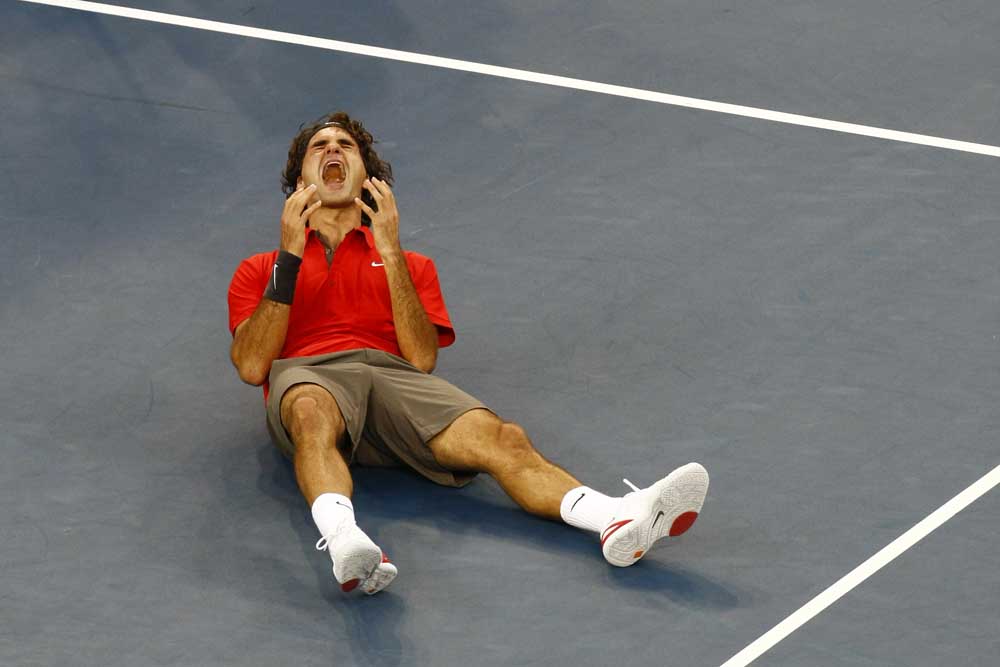Half a century of Open moments
Published 12:00 am Sunday, August 26, 2018

- Roger Federer wins his fifth consecutive U.S. Open title in 2008. Since 1968, the Open has given New York every imaginable tennis high and low. (Uli Seit/The New York Times, file)
From heroic highlights to the low points of bad behavior, the U.S. Open has delivered 50 years of memories from 1968 to 2018. Here are just a few.
A historic first
Arthur Ashe was the first black tennis player to win the U.S. Open in its 1968 inaugural year, the first Grand Slam event of the Open era. Then an amateur player, and a lieutenant in the U.S. Army, Ashe took leave from his station at West Point to beat Roy Emerson in the fourth round, Cliff Drysdale in the quarterfinals, Clark Graebner in the semifinals and Tom Okker in a five-set final.
Because he was playing as an amateur, Ashe was unable to accept the champion’s prize of $14,000. He took home a $20 per diem during the tournament for a total of $280.
Miss poker face
As a 16-year-old at the 1971 U.S. Open, Chris Evert took two weeks off from high school to play. She was young, quiet and rarely showed any emotion during play.
These characteristics earned the nicknames Little Miss Poker Face, Chris America and Little Ice Woman. She was also armed with a rare and deadly two-handed backhand that dispatched older players as she advanced to the semifinals. “Chris has really helped women’s tennis,” Billie Jean King said after beating Evert that year in straight sets. “What it needs is more personalities. If any of the other girls feel jealous about the attention she’s received, they should stop and think beyond their own little worlds.”
Breaking barriers
In 1977, Renee Richards became the first transgender player in the U.S. Open. Born Richard Raskind, Richards competed several times in the men’s U.S. National Championships in the 1950s and 1960. After a sex-change operation in 1975, she began playing tournaments as a woman, but was denied eligibility for the 1976 Open for refusing to take a chromosome test to determine her gender. She sued the U.S. Tennis Association, and a New York Supreme Court justice ruled in her favor just weeks before that year’s Open, where she lost 6-1, 6-4 to Virginia Wade in the first round.
Meeting her match
By the 1980 Open, Evert had met her match in Tracy Austin, another all-American blonde who had ended Evert’s 125-match clay court winning streak and her four-year reign as Open champion one year earlier. When they met again in 1980, Austin seemed poised to unseat Evert for good as No. 1. In what the media called her “return to the throne,” Evert played as if she had something to prove to both her challenger and the tennis world. She beat Austin 4-6, 6-1, 6-1 and went on to win her fifth Open.
A rivalry ends
Brash American John McEnroe and stoic Swede Bjorn Borg enjoyed one of sport’s best rivalries, playing 22 times between 1978 and 1981, splitting the wins evenly. They met for the last time at the 1981 Open, one year after McEnroe lost to Borg at Wimbledon in what was widely considered one of the best tennis matches ever played. Now, in McEnroe’s hometown, the New Yorker soundly beat Borg for the last time, 4-6, 6-2, 6-4, 6-3. Borg walked off the court ignoring the on-court presentations and the news conference. He retired shortly after.
The golden slam
Steffi Graf made history in 1988 when she beat Gabriela Sabatini 6-3, 3-6, 6-1 in the U.S. Open final. She completed the Grand Slam, winning each of the four majors in the same year, having already won the Australian Open, the French Open and Wimbledon. To sweeten the year, Graf beat Sabatini once again later that month in the finals at the 1988 Summer Olympics in Seoul, South Korea, to win gold, making her year a Golden Slam.
A legend’s run
In 1991, 39-year-old Jimmy Connors showed the world he would not go quietly into retirement. His Open run was part combat and part entertainment as he capitalized on the crowd’s adrenaline, making it to the fourth round, where he leveled return after return against a stunned Aaron Krickstein. “I feel better than I look, don’t worry,” he said during the match. Behind 5-2 in the last set, Connors came back to win 3-6, 7-6, 1-6, 6-3, 7-6. “This is what they pay for, this is what they want,” he said. Next, Connors dispatched Paul Haarhuis 4-6, 7-6, 6-4, 6-2, giving the crowd a show by returning four consecutive overheads before placing a winning backhand shot down the line. Connors lost the next round to Jim Courier 6-3, 6-3, 6-2 in the semifinals, but it did not matter — he had already won the crowd.
The longest match
In 1992, American Michael Chang and Swede Stefan Edberg met in the semifinals, and their playing styles clashed immediately: Edberg quietly dominated the net while Chang played slow and steady, a classic serve-and-volley player pitted against a baseline hitter. And on it went for five sets lasting 5 hours, 26 minutes, the longest match in Open history. Edberg, the defending champion, won out the endurance contest, beating Chang 6-7, 7-5, 7-6, 5-7, 6-4. Neither played their finest tennis, and both blew big leads, but the sheer length was remarkable. “I think in these long matches, you lose a few brain cells,” Chang told reporters.
Down, not out
It may not be a highlight, but it was certainly memorable. American Pete Sampras was battling a stomach bug in the quarterfinals playing the unseeded Spaniard Àlex Corretja at the 1996 Open. For most of the match, he stumbled around “like a bear who had been aroused from hibernation against his consent,” reported The Times. Finally, during the fifth set, he leaned over and heaved near the baseline. The chair umpire warned him of a time violation and to not throw up again or risk being disqualified. Sampras held it together to finish the match and managed a victory over Corretja 7-6, 5-7, 5-7, 6-4, 7-6.
The ugly ‘Bump’
Things at the 1997 Open got ugly when Romanian Irina Spirlea tried to throw Venus Williams off her game late in the third set by deliberately walking into the American during a changeover. Spirlea complained about Williams and admitted fault. Venus’ father, Richard Williams, called Spirlea a “tall, white turkey” and claimed the collision — now infamously known as “the Bump” — was racially motivated. “At the time it felt dangerous,” S.L. Price wrote in Sports Illustrated. “The ugliness that consumed the 1997 U.S. Open seemed unstoppable. Few, if any, sporting events, in America, had been so charged, so flammable.”
All-American battle
The 2005 Open saw two Americans battling it out in the quarterfinals late into the night: the energetic upstart James Blake and Andre Agassi, a veteran nearing the end of his career. Blake came out with blazing speed and precision, winning the two first sets against a stunned Agassi. The third set saw a refreshed Agassi, but Blake pushed back before finally falling under pressure and losing 3-6, 3-6, 6-3, 6-3, 7-6. “It couldn’t have been more fun to lose,” Blake told Agassi at the net. Later, Agassi addressed the crowd. “At 1:15 in the morning for 20,000 people to still be here, I wasn’t the winner, tennis was,” Agassi said.
A tearful farewell
Agassi played his final match and last U.S. Open on Sept. 3, 2006, taking a bow in the third round after losing in four sets to Germany’s Benjamin Becker 7-5, 6-7, 6-4, 7-5. After the emotional match, he wiped tears and addressed the packed stadium. “The scoreboard said I lost today. But what the scoreboard doesn’t say is what it is I have found. Over the last 21 years, I have found loyalty. You have pulled for me on the court and in life. You have given me your shoulders to stand on, to reach for my dreams, dreams I could never have reached without you. I will take you and the memory of you with me for the rest of my life.”
The expensive threat
It would be an understatement to say Serena Williams lost her composure during her 2009 loss against Kim Clijsters. Fresh out of retirement, Clijsters won the first set 6-4. Down 5-6 in the second set, a line judge called a foot fault on Williams, the tournament favorite. Williams charged the line judge and waved her racket and ball in her face. “I swear to God I’m (expletive) going to take this (expletive) ball and shove it down your (expletive) throat, you hear that? I swear to God.” Williams was fined $82,500, and tennis fans saw a nasty new side of the tennis legend.
Five in a row
After Roger Federer in 2008 became the first man in the Open era to win the U.S. Open for a fifth consecutive time, The Times wrote this: “As befits his cosmopolitan lifestyle, Roger Federer owns homes all over the world: Oberwil, Switzerland; Wimbledon, England; Flushing Meadows.”






